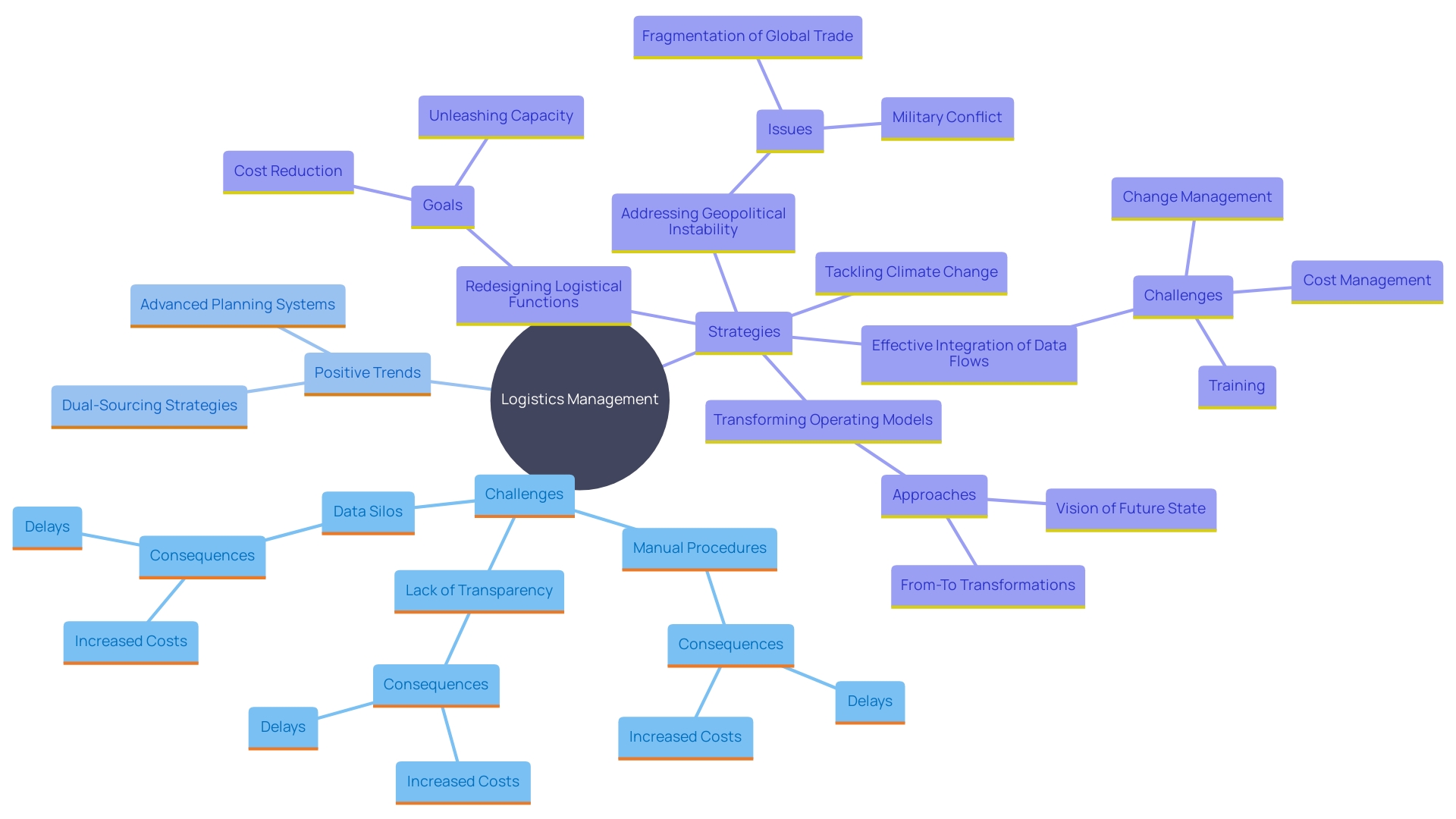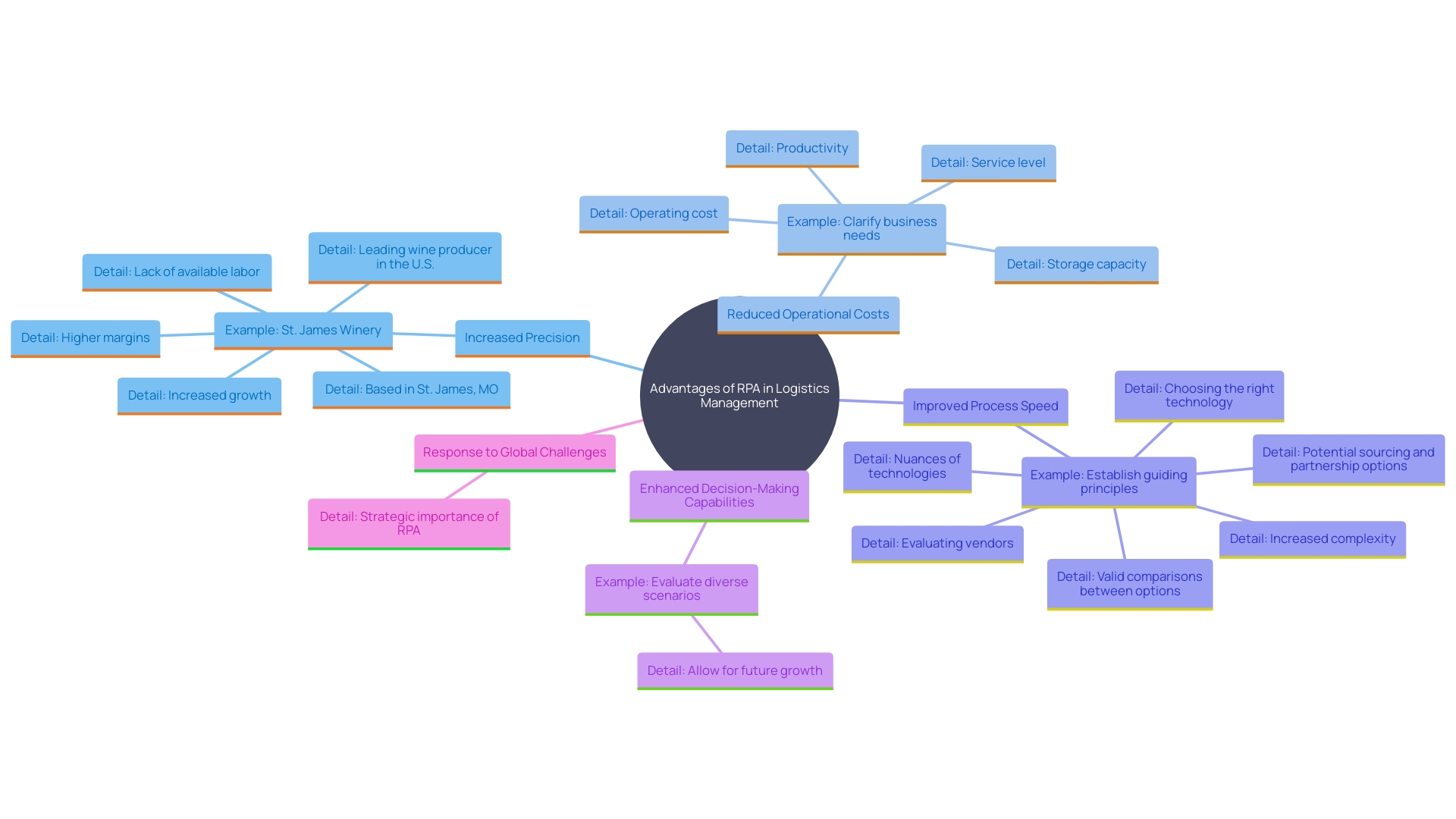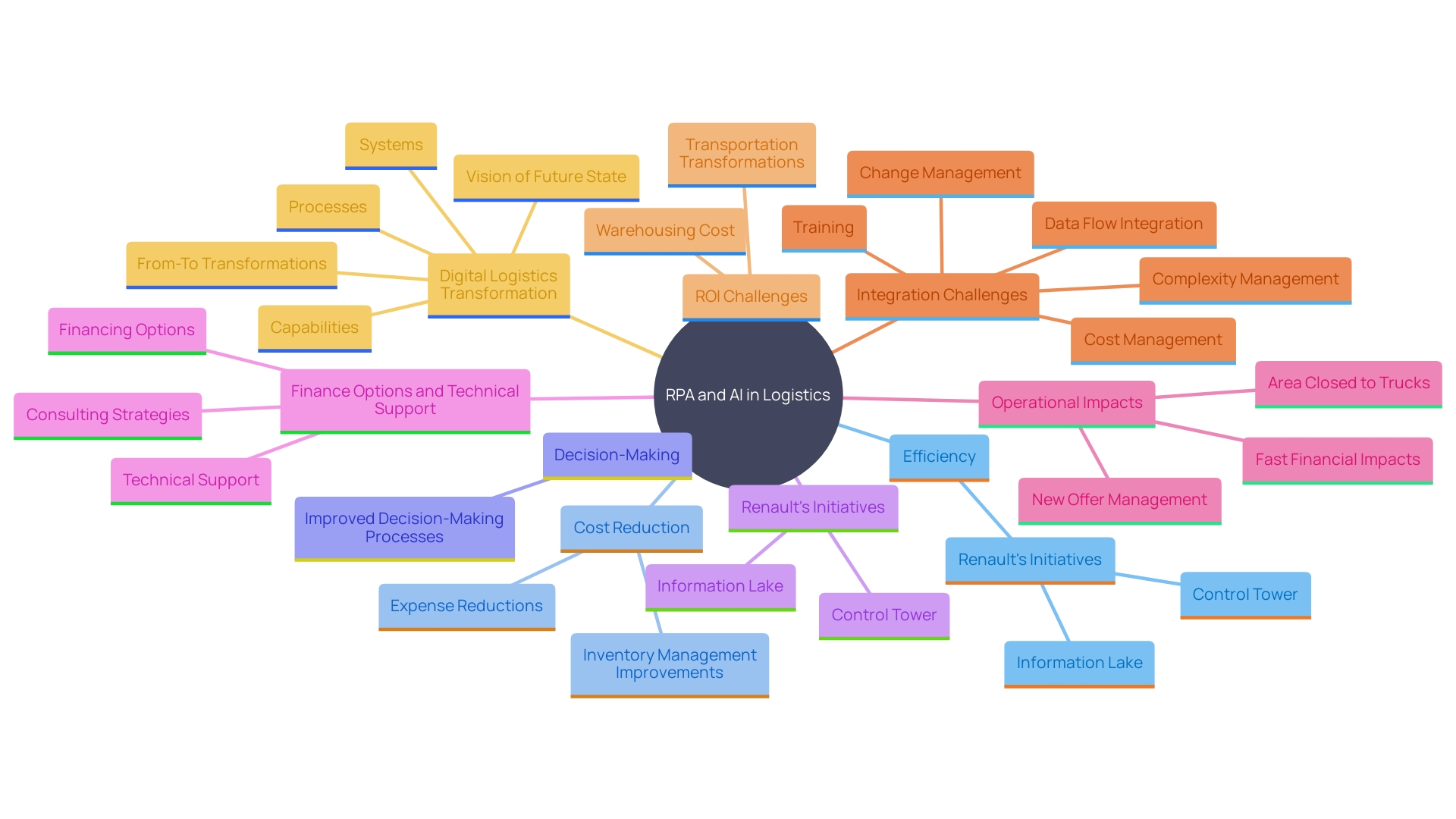Introduction
Navigating the complexities of modern supply chain management requires more than just traditional methods. With challenges such as manual processes, lack of visibility, and inefficient communication, many organizations find themselves grappling with delays, increased costs, and errors. However, a transformative shift is on the horizon.
Robotic Process Automation (RPA) is revolutionizing the supply chain landscape by automating repetitive tasks, enhancing accuracy, and enabling faster decision-making. This article delves into the pressing challenges of traditional supply chain management, elucidates the benefits and key applications of RPA, and offers best practices for its implementation. Additionally, it explores the synergistic potential of combining RPA with Artificial Intelligence (AI) to create advanced, resilient supply chains.
Discover how leveraging these technologies can elevate operational efficiency, reduce risks, and provide a strategic advantage in today’s dynamic market.
Challenges in Traditional Supply Chain Management
Conventional logistics management often struggles with manual procedures, absence of transparency, and ineffective communication. These issues lead to delays, increased costs, and errors that hinder overall productivity. Data silos, where information isn’t shared across departments, lead to poor decision-making and a reactive approach to logistical challenges. Based on recent surveys, merely 60% of companies possess thorough insight into their tier-one suppliers, emphasizing a notable deficiency in logistical intelligence. Moreover, fewer than a quarter of organizations have formal procedures to address procurement issues at the board level, leaving firms vulnerable to risks and interruptions.
On the positive side, 73% of companies report progress on dual-sourcing strategies, and 60% are regionalizing their logistics to mitigate risks. This shift towards resilience is also seen in the implementation of advanced planning and scheduling (APS) systems, with two-thirds of respondents making headway. These systems enhance planning accuracy, enable rapid responses to disruptions, and improve overall resilience. As Melissa Twiningdavis, Senior Managing Director of Supply Chain Operations at Accenture, notes, “In today’s environment, the challenge is to drive cost efficiency while continuing to embed and accelerate resiliency.”
Companies like OnProcess are leading the transformation in supply chain operations by leveraging domain talent, data, and processes to create end-to-end solutions. ‘This emphasis on logistics operations has become an essential source of competitive edge, highlighting the necessity for thorough risk management and proactive strategies to navigate the intricacies of contemporary logistics.’.

Benefits of RPA in Supply Chain Management
Robotic Process Automation (RPA) provides transformative advantages in logistics management, driving increased precision, lowered operational expenses, and improved process speed. By automating repetitive and rule-based tasks, RPA significantly minimizes human error and liberates employees to concentrate on strategic initiatives. For instance, St. James Winery in Missouri leveraged automation to address labor shortages and improve production efficiency, resulting in higher margins and faster production speeds.
Furthermore, RPA offers real-time information access, which is essential for improved decision-making and quick reactions to market changes. “As stated by Steve Murphy from Panorama Consulting Group, the pace of information transfer in logistics has changed significantly, improving information precision and operational velocity.”. This evolution, coupled with the ability of RPA to handle data swiftly, ensures that goods move quicker from receiving purchase orders to shipping.
As worldwide distribution networks encounter persistent issues like geopolitical tensions and strict regulations, the implementation of RPA is becoming essential. The Capgemini Research Institute underscores the significance of robust and effective logistics networks, stressing that technologies such as RPA are crucial in managing these challenges. Additionally, the growing demand for automation is evident, with companies planning to increase their investment significantly over the next five years, as noted by industry experts.
In summary, RPA not only improves operational efficiency but also offers a strategic edge in navigating the dynamic environment of global logistics.

Key Applications of RPA in Supply Chain
RPA can transform logistics operations by automating order processing, enhancing inventory management, and improving shipment tracking. For instance, automated storage and retrieval systems (AS/RS) provide real-time visibility of inventory, dramatically reducing product damage and waste by minimizing manual handling. This shift has more than doubled capacity for some organizations, showcasing how RPA can transform previously manual operations into efficient automated workflows.
In the automotive sector, overseeing the accuracy and responsiveness of resources has become essential. Firms such as Renault have embraced a digital strategy to manage logistical tensions, highlighting the significance of a Strategic Operations and Planning (S&OP) depth of 24 months to alleviate component crises. This highlights how RPA can enhance operational efficiency and ensure timely responses to market demands.
Additionally, the integration of AI and robotics within warehouses has significantly advanced inventory management. Modern tracking systems with RFID technology streamline the flow of goods from receiving to shipping, ensuring accuracy and speed. With AI investments on the rise, companies are achieving substantial revenue increases, demonstrating the financial benefits of adopting RPA technologies.
Overall, the implementation of RPA in logistics enhances workflows, decreases lead times, and satisfies customer needs effectively, presenting a strong argument for its broad adoption.
![]()
Best Practices for Implementing RPA in Supply Chain
Effectively executing RPA in the logistics network requires a calculated and carefully planned method. Begin with a thorough process assessment to identify areas ripe for automation, such as repetitive tasks and data-driven operations. Engaging stakeholders from different departments is crucial to ensure alignment and mitigate resistance to change. St. James Winery, for instance, successfully navigated these challenges by involving various teams early in the automation process, resulting in higher margins and operational efficiency.
Establishing clear metrics for success is vital. For example, metrics could include reduced processing times, error rates, and cost savings. Monitoring these metrics continuously will refine the RPA implementation over time, ensuring maximum impact. According to a recent global survey of 1,639 automation professionals by UiPath, organizations that set clear performance indicators saw a significant improvement in their automation initiatives.
Moreover, leveraging the expertise of professionals and integrating advanced technologies like AI can enhance decision-making processes. As mentioned by Melissa Twiningdavis, Senior Managing Director of Logistics Operations at Accenture, the emphasis on logistical processes has become a crucial source of competitive edge. By integrating domain expertise, information, and processes, organizations can successfully transform their operations.
To illustrate, only a few companies have progressed to the advanced phases of digital transformation, using intelligent workflows to orchestrate logistics processes. This highlights the importance of adopting a deliberate approach to transformation, recognizing the value of employee buy-in and proper data encapsulation. As digital transformation continues to evolve, it fundamentally changes how organizations create value within their distribution networks, making it essential to stay ahead of technological advancements.

Combining RPA with AI for Advanced Supply Chain Automation
Combining RPA with Artificial Intelligence (AI) can greatly improve logistics efficiency and resilience. While RPA streamlines repetitive tasks, AI provides advanced information analysis capabilities, promoting more intelligent decision-making. Renault’s logistics digitalization journey exemplifies this synergy. By establishing a comprehensive information lake and allocating a substantial part of their IT budget to structuring, Renault has built a strong base for integrating AI. This has facilitated the creation of an advanced control tower that accurately oversees factory resources, as detailed by Ludovic Doudard, General Manager Process Engineering Logistics at Renault.
AI’s impact extends beyond data analysis. “AI simulation platforms, such as those emphasized by Michel Morvan, Co-founder and Executive Chairman of Cosmo Tech, offer managers with insight into the possible effects of choices, enhancing trade-offs between profitability, service levels, and sustainability.”. These platforms enable the modeling of logistics behavior under different scenarios, assisting companies in predicting interruptions and adjusting as needed.
The benefits of integrating AI and RPA are quantifiable. According to McKinsey, businesses employing AI and machine learning in their logistics can lower expenses by 10%. Additionally, AI-driven demand forecasting and inventory management can lower inventory carrying expenses by 20% and minimize stockouts by 50%, improving overall system resilience.
Renault’s commitment to AI is further evidenced by their ambitious goal to generate 45 million euros in digital value through AI projects, supported by the Dataiku platform. This initiative highlights the transformative potential of AI in logistics management. By leveraging both RPA and AI, businesses can create more agile, responsive, and efficient supply chains, capable of navigating the complexities of the modern market.

Conclusion
The challenges facing traditional supply chain management are significant, marked by issues like manual processes, lack of visibility, and inefficient communication. These hurdles can lead to delays, increased costs, and errors that compromise productivity. However, a proactive approach is emerging, with organizations increasingly adopting technologies such as Robotic Process Automation (RPA) to enhance operational efficiency and resilience.
By automating repetitive tasks and improving data access, RPA not only minimizes human error but also empowers teams to focus on strategic initiatives.
The applications of RPA in supply chain functions are vast, ranging from automating order processing to enhancing inventory management. Companies that have embraced RPA are witnessing transformative changes, such as improved shipment tracking and better responsiveness to market demands. The integration of RPA with Artificial Intelligence (AI) further amplifies these benefits, enabling smarter decision-making and advanced data analysis.
This combination fosters a supply chain environment that is both agile and resilient, adept at navigating the complexities of a dynamic market landscape.
Implementing RPA requires a strategic approach, beginning with a thorough assessment of processes to identify automation opportunities. Engaging stakeholders and establishing clear metrics for success are critical steps in this journey. Companies that prioritize these best practices are better positioned to realize the full potential of RPA, leading to enhanced operational efficiency and competitive advantage.
As the landscape of supply chain management continues to evolve, embracing these innovative technologies will be essential for organizations aiming to thrive in an increasingly complex environment.

